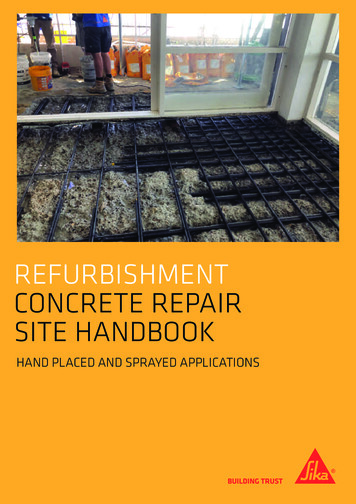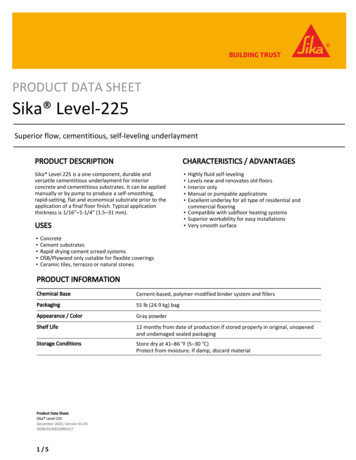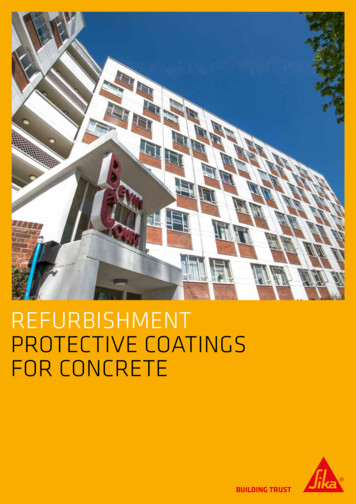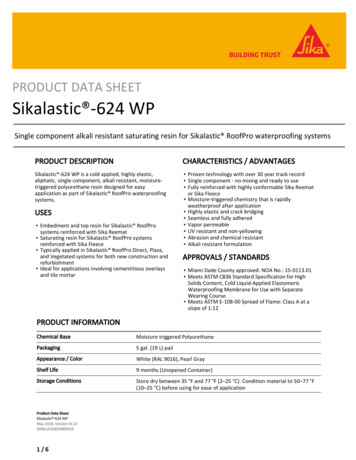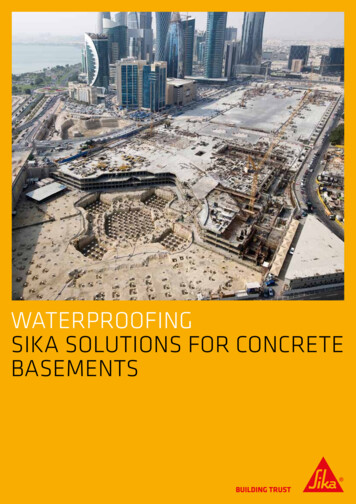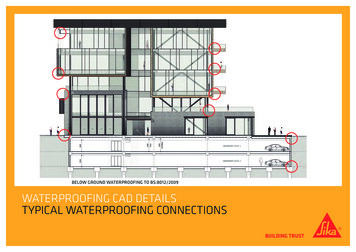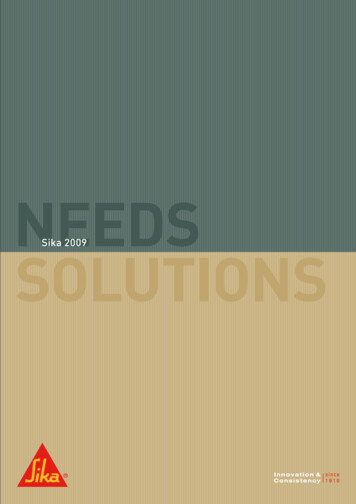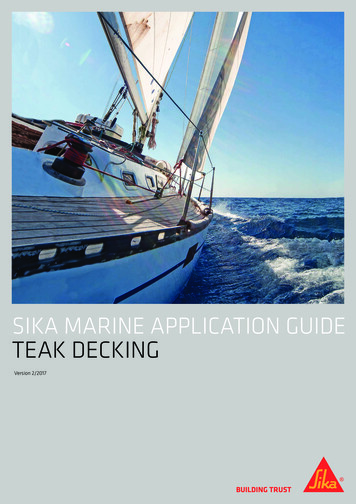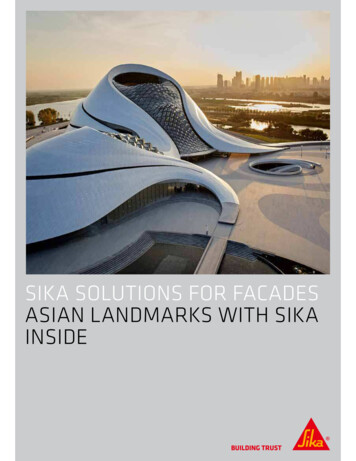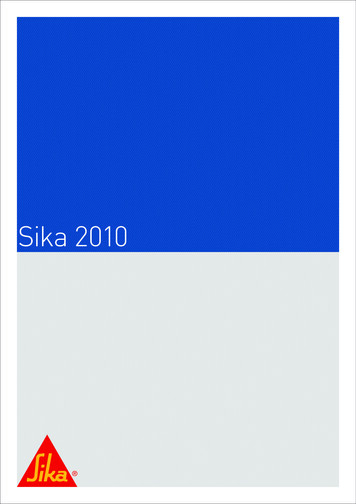
Transcription
Sika 2010
—In local currencies, sales were up 10.2% year on year,and net profit 37.7%.Sika again succeeded in gaining market share in 2010.Strong growth in all markets: Low single-digitgrowth in the mature markets, double-digit growthin the emerging markets.Growth in local currencies Region Asia/Pacific: 41.4%.Growth in local currencies Region Latin America:18.0%.Table of Contents.235711121325262728301Sika 2010Brief OverviewGroupCustomers and MarketsProducts and InnovationOrganizational DiagramGroup ManagementWaterproofingConsolidated Balance SheetConsolidated Income StatementConsolidated Cash Flow StatementFive-Year ReviewsImprint
—Brief OverviewNet sales by Division(consolidated)Net sales by Region(consolidated)Europe NorthCHF1 457 mn (33.0%)Europe SouthCHF 874 mn (19.8%)North AmericaCHF633 mn (14.3%)Latin AmericaCHF480 mn (10.9%)IMEA*CHF286 mn (6.5%)Asia/PacificCHF676 mn (15.3%)Central servicesCHF10 mn (0.2%)TotalCHF 4 416 mnConstructionCHFIndustryCHF3 551 mn (80.4%)865 mn (19.6%)* India, Middle East, Africaportrait And CORE COMPETENCIES. Sika AG, locatedin Baar, Switzerland, is a globally active specialtychemicals company. Sika supplies the building andconstruction industry as well as manufacturing industries (automotive, bus, truck, rail, alternative energies,building components). Sika is a leader in processingmaterials used in sealing, bonding, damping, reinforcingand protecting load-bearing structures.Sika’s product lines feature high-quality concrete admixtures, specialty mortars, sealants and adhesives,damping and reinforcing materials, structural strengthening systems, industrial flooring as well as roofing andwaterproofing systems. Worldwide local presence in 74countries and some 13 500 employees link customersdirectly to Sika and guarantee the success of all partners.Sika generates annual sales of CHF 4.4 billion.Sika Groupin CHF mn2009Net sales4 154.9Depreciation/amortization/impairmentas % ofnet sales2010as % ofnet sales4 416.0-139.3-3.4-137.5-3.1Operating profit before restructuring400.69.6439.510.0Net profit after taxes225.75.4310.97.0Earnings per share in CHF1Cash flow from operating activities91.03526.3124.6012.7424.89.6Free cash flow312.57.5243.95.5Operating free cash flow368.78.9332.27.5Balance sheet total3 629.43 931.7Shareholders’ equity1 593.01 752.243.944.6Equity ratio in %2ROCE in %Number of employeesNet sales per employee in CHF 1 000312319.321.312 36913 482329342Excluding minority interestsShareholders’ equity divided by balance sheet totalCalculated based on the annual average of number of employeesSika 20102
—Groupencouraging increase in sales and net profit. Sika posted a 6.3% increase in sales in the 2010business year, achieving net sales of CHF 4.416 billion. In local currencies, Sika lifted sales by 10.2%.Consolidated net profit amounted to CHF 310.9 million, 37.7% above the previous year’s level ofCHF 225.7 million.SALES. The 6.3% increase in annual net sales to CHF4.416 billion comprises organic growth (6.1%), growththrough acquisitions (4.1%) and a negative currencyeffect (-3.9%).Sika’s performance in the year under review varied considerably from Region to Region. While the high turnoverRegions Europe and North America achieved only a veryhesitant recovery, Sika posted substantial gains in theemerging markets throughout the entire year. Growthrates in the individual Regions in local currencies: Europe North 4.5%, Europe South 1.7%, North America8.5%, Latin America 18.0%, IMEA (India, Middle East,Africa) 9.5%, Asia/Pacific 41.4%. Particularly developments in North America and Asia/Pacific were additionally influenced by acquisitions.Owing to the significant increase in sales achieved inemerging markets, the proportion of Sika Group salesgenerated by these countries rose to 36%.In local currencies, Group sales of products for the building and construction industry were up by 8.7% in the2010 business year; of this figure, 4.9% were attributableto acquisitions. Sales of products for industrial manufacturing increased 16.7% in local currencies, including anacquisition effect of 0.6%.3Sika 2010The strong franc was not without influence on the salesfigures. The overall currency effect of -3.9% almost exclusively corresponds to a translation effect. The currencyeffect was particularly substantial in the final quarter of2010. The Group’s decentralized regional structuringand the largely local-based generation of value addedat Sika’s 120-plus locations in 74 countries provides agood natural hedge against exchange rate movements.During the reporting period Sika acquired six companies:The auto glass replacement business of ADCO Products, Inc., USA, the construction sealants operations ofHenkel Japan Ltd., Czech-based flooring manufacturerPanbex Group, structural waterproofing manufacturersDyflex HD Co. Ltd., Japan, Greenstreak Group, Inc.,North America, and US-based silicone and polyurethaneproducts manufacturer May National Associates, Inc.
—Net sales(consolidated)in CHF mnOperating profitin CHF mnConsolidated net profitafter taxesin CHF mnCash flow fromoperating activityin CHF mn5 0005005005004 0004004004003 0003003003002 0002002002001 080910PROFIT. Raw material prices witnessed increases inLIQUIDITY AND BALANCE SHEET. Operating free cash2010, owing primarily to low supplier capacity at thebeginning of the year coinciding with increased demand.The fact that higher raw material prices could only bepassed on to sales prices after a certain time lag squeezedthe gross margin. Overall, Sika increased its gross profitto CHF 2.385 billion (2009: 2.295 billion), correspondingto a gross margin of 54.0%.flow reached CHF 332.2 million (2009: CHF 368.7 million) in the year under review. Cash and cash equivalents increased from CHF 801.6 million to CHF 938.4million as of the end of the year. Net debt could bepared from CHF 264.8 million to CHF 164.5 million,reducing the ratio of net debt to shareholders’ equity(gearing) from 16.6% to 9.4%. The syndicated creditlimit of CHF 450 million was not drawn on in 2010. Itexpired on November 15, 2010. Given the company’shigh level of cash holdings, Sika opted not to have thelimit extended.Sika improved operating profit before restructuring by9.7% to CHF 439.5 million (2009: CHF 400.6 million;2009 operating profit after restructuring: 344.0 million),resulting in an operating profit margin of 10.0%. At CHF310.9 million (2009: CHF 225.7 million), consolidated netprofit was up 37.7% year on year. One-off tax effectsalso had a positive impact on consolidated net profit.INVESTMENTS. Sika’s unchanged investment strategy isgeared to consolidating its global presence, built up during the last few years, and unlocking new markets orexpanding its existing activities. To encourage focusedgrowth, selected markets, customers, technologies andproducts are prioritized. Given the changed economicclimate triggered in many parts of the world by the financial crisis, Sika has reviewed all investment plans andadjusted these to the new conditions. The volume of investment during the period under review therefore remainedbelow the level of the previous years at CHF 100 million.Sika 20104
—Customers and MarketsIndividual Solutions for Global Requirements. Sika’s growth strategy focuses on four customer groups, whose varying requirements are actively addressed and conscientiously met at global,regional and local level.CUSTOMERS. Sika’s marketing, service and sales opera-tions are geared to four key customer groups, each withits own special demands.Concrete producers (“Concrete”) need cost-optimizedsolutions, purpose designed for the particular cementand application, and subject to individual fine-tuning inready-mixed and precast concrete plants, or on the jobsite. As a result, Sika’s business success largely hingeson its presence in all relevant local markets. Key accountmanagement is, however, also playing an ever moreimportant role due to the increasingly globalized operations of major cement and concrete producers.Specialized applicators (“Contractors”) purchase Sikaproducts, such as Sikaplan or Sarnafil polymeric sheetmembranes, which they then incorporate as waterproofbarriers in roof or basement constructions. They useliquid polymers to install industrial flooring or protectivecoatings, and apply sealants and adhesives to preventwater infiltration through structural joints or to bondwooden floor finishes. As these works are always partof a larger scheme, Sika offers its support and knowhow to owners, architects, engineers and other involvedparties at the earliest possible project stage. The professional counseling of all project parties is the key tosuccess. This holistic approach is enshrined in the Sikawatchword: “From Roof to Floor.”Builders’ merchants (“Distribution”) play a more or lessprominent role in different countries, depending on thetraditional organization of the construction sector. Insome countries, the smaller tradesmen’s businessesobtain materials from building supplies stores, while the5Sika 2010larger contractors and specialist applicators purchasetheir products directly from Sika. In other countries,builders’ merchant outlets represent the principal distribution channel for practically all users. In the latter case,merchants also act in an advisory capacity and helptradesmen to tackle the diverse challenges arising on thejob site. This function is particularly important for Sikain the emerging markets, e.g. India or Latin America,given that merchants act as disseminators and promote market penetration.Industrial customers (“Industry”) require Sika productsthat are tailored to their particular needs – and thesegenerally in bulk. Here, the focus tends to be on bonding, reinforcing and soundproofing applications. Sikatechnologies are primarily employed in the manufactureof automobiles, buses, trucks, railway cars and ships.Other sectors offering attractive sales potential includeindustrial window production, wind turbines and solarpower stations.REGIONS. Sika has grown continuously since its foundation in 1910. The first subsidiary outside Europe wasestablished as early as 1932 in Japan. The Group wassplit into Regions at an early stage so as to allow thenational organizations to capitalize on synergies and setup further companies. These Regions, currently six innumber and headed by regional managers since 1993,now effectively shape the company’s managementstructure. The regional managers are members of GroupManagement and assume line responsibility for their Region. The regional management structures encompasssales functions as well as the marketing and development activities geared to the customer groups.
—In 2002, following strong growth, the Region Europewas segmented into the Regions Europe North andEurope South. The latest restructuring, in 2006, set outto exploit Sika’s full potential in the Middle East, wherethe company was thought to have underperformed foryears. The grouping together of the Middle East with India and South and East Africa led to the creation of thenew IMEA (India, Middle East and Africa) Region. Thereorganization has paid dividends: Since its formation, theRegion IMEA has been one of Sika’s growth engines.Worldwide Market PresenceNorth AmericaSales in CHF mn633Latin AmericaSales in CHF mn480Europe NorthSales in CHF mn1 457Europe SouthSales in CHF mn874IMEASales in CHF mn286Asia/PacificSales in CHF mn676Countries with Sika subsidiaryCountries with sales representativeSika 20106
—Products and InnovationInvestment in a Sustainable Future. Products that have been on the market for a maximumof five years accounted for 30.3% of Sika sales in 2010. This success largely derives from the company’sstrategic focus, expert research and development management primarily geared to client projects,efficient development processes and a targeted response to the needs of the customer groups.INNOVATION AND GROWTH. Innovation is a key driver inthe successful implementation of the company’s growthstrategy. It makes a major contribution to the achievement of an average medium-term organic growth of8 to 10%. Research and development (R&D) enjoy anaccordingly high priority within the company. The R&Dstrategy adopted by Sika in recent years has yielded ahigh innovation rate, with numerous patents plus a hostof new products. Products that have been on the market for only five years or less accounted for 30.3% ofSika sales in the reporting year.CORE COMPETENCIES. One key factor for the success ofSika’s R&D work is its strategic focus on clearly definedcore competencies, namely: Sealing, bonding, damping,reinforcing and protecting of load-bearing structures inbuilding and industry.Sealing. Sealing minimizes the infiltration of gases andliquids through voids and cavities as well as the transmission, spread or loss of heat. Large expanses of flatroofing, complex tunnel systems, damage-prone waterretaining structures and sophisticated wall-claddingassemblies are durably weatherproofed and maderesistant to temperature fluctuations, aging and vibration – thereby enhancing the functionality and comfortof the interior environment.7Sika 2010Bonding. Bonding ensures the permanent, elastic andstructurally continuous connection of different materials.Innovative processes are used to bond vehicle components, window assemblies or even concrete bridgeunits weighing several tons. Sika’s bonding technologyenhances the safety of end products while increasingdesign freedom. These applications may also be usedto optimize manufacturing processes and reduce cycletimes.Damping. Damping reduces vibrations of all frequenciesin fixed and moving objects, thereby lowering resonanceand noise emission in load-bearing structures and cavities.The attenuation of noise, for instance, in vehicle interiors – in cars, on buses or on cruise ships – significantlyincreases the comfort of drivers and passengers alike.Reinforcing. Reinforcing components are strategicallyincorporated in structures to improve their resistance tostatic and dynamic loads. Applications range from lightweight window frames and crash-resistant car bodiesto monumental concrete bridges. These solutions canbe used to strengthen existing and optimize new-buildload-bearing structures.Protecting. Protective elements increase the durabilityof load-bearing structures and help to preserve the fabricof new and renovated facilities. Sika’s solutions guaranteelong-term protection for concrete and steelwork assemblies against climatic conditions, chemical action, pollution and fire.
—RESEARCH STRATEGY. At Sika, research and development are dictated by two main factors. The first ofthese relates to global trends driven by the principlesof sustainable development, such as the demand forresource-saving building methods, energy-efficientconstruction materials or lightweight vehicles. The second relates to the considerable adaptation of productsnecessary to meet local needs, which vary accordingto the particularities of construction industry in differentcountries – e.g. with regard to raw materials, climate orlegal framework. Accordingly, Sika’s research strategyhas both centralized and decentralized components.The centralized elements of the research strategy aredevolved to the subsidiary Sika Technology AG, whichis responsible for long-term research programs, analytical services and research management. The long-termresearch programs are geared to the technology roadmaps governed by the five megatrends (populationgrowth in the emerging countries, increasing urbanization, greater standardization, mounting shortages ofnatural resources, and more intensive environmentalprotection). Here, the identification of new products oralternative raw materials is only one aspect. Equallyimportant is the refinement of existing products or theirintroduction in new fields of application.Corporate expert teams play a crucial role in the management of research and development projects. Theseglobal teams include representatives from wide-rangingcorporate functions, such as purchasing, development,fabrication, marketing and logistics. They ensure thatthe different perspectives are given due considerationin projects.The decentralized components of Sika’s research strategy are entrusted to the eleven technology centers inAmerica, Europe and Asia. These sites assume specifictechnology responsibilities and develop new productsand applications independently. The technology centersalso support the global market launch of their innovations. For this, they liaise closely with regional and localcustomer-oriented laboratories. This allows the swift adjustment of new products to local requirements, e.g. thefine-tuning of concrete admixtures to climatic conditionsor to locally sourced aggregates such as gravel or sand.The Sika technology centers are also responsible for finding local raw materials that allow production costs to beminimized.Sika 20108
—COLLABORATIONS. In the field of basic research, Sikarelies mainly on collaborations with premier universities inSwitzerland, the USA, Germany, Spain, France, China,India and other countries. In one initiative, Sika is sponsoring a new professorship for sustainable constructionat the ETH (Swiss Federal Institute of Technology) Zurich.The partnership entailed a one-time funding contribution to the ETH Zurich Foundation of CHF 7 million. Thecombination of shared interests and geographic proximity often spawns prompt, unbureaucratic solutions thatbring obvious benefits for the company. At the sametime, Sika is at pains to counteract the prevailing shortage of engineers and chemists in certain countries byattracting suitable candidates to the company.Sika is permanently engaged in a range of internationalprojects such as the NanoCem consortium. This European research network studies nanoscale and microscalephenomena that influence the performance of cementitious materials and the products and structures in whichthey are used. Sika collaborates with its key suppliersand customers to promote innovation as early as possible in the supply chain and pave the way for the use oftailored intermediate products.9Sika 2010Sika Technology AG participates actively in a range ofprojects funded by the European Union:– FUTURA: Integration of multifunctional materials inthe automotive industry and introduction of modularand scalable approaches for designing and producingvehicles (www.futura-ip.eu)– MUST: Development of chromium-free anticorrosion systems for steel and lightweight alloys(www.must-eu.com)– i-SBB: Safe and intelligent construction methodsfor high-earthquake-risk areas (conclusion at endof 2010)– TunConstruct: Research and development for innovative tunneling methods, materials and machines (conclusion at start of 2010; www.tunconstruct.org)Sika Technology AG participates in the United NationsSustainable Buildings and Climate Initiative (SBCI;www.unepsbci.org), whose aim is to establish sustainable building practices worldwide. Sika also sponsorsthe YES (Youth Encounter on Sustainability) programwhich targets future leaders in the field of sustainability.Moreover, the Group has been a member of the WBCSD(World Business Council for Sustainable Development)since 2010.
—innovation. Expenditure on research and develop-ment in the Group in the year under review totaled CHF74.4 million (2009: CHF 74.7 million), roughly equivalentto 1.7% of sales (2009: 1.8%). The R&D budget wasallocated in accordance with strategic priorities.The Sika Group’s Corporate R&D unit is aligned with theenterprise strategy and focuses on research into technology platforms and implementation procedures for highpriority R&D projects in the development departments.The seven-stage development process for products, theso-called Product Creation Process (PCP), is employeduniformly worldwide to ensure that new and patentedproducts can be brought to market as quickly as possible. Yet, apart from short time to market, Sika also aimsfor high efficiency and strives to achieve cost leadershipfor its products in all target markets. In collaborationwith Corporate Operations, the R&D unit also works tostreamline the comprehensive product range in order toconsolidate, simplify and lower the cost of marketing,production and distribution processes.The regional technology support functions are responsible for compliance with the PCP in their area andperform regular PCP audits to review process quality.The audits ensure that employees always apply anup-to-date state of knowledge so as to meet the highstandards specified by Sika and that local chemists arekept abreast of the latest technologies. At the sametime, innovative ideas from the Regions are collectedand leveraged for the Group.2010 saw Sika launch a number of new important products onto the market:– Rollout of first adhesives and sealants employinginnovative i-Cure technology– Introduction of three new adhesives for global automotive manufacturers plus innovative SikaPower structural adhesives for use in vehicle bodyworkconstruction– For shotcrete: New Sika ViscoCrete superplasticizeralong with new accelerators– Launch of Sika ViscoFlow superplasticizer basedon new polymer concepts– Rollout of new two-component polyurethane adhesives for wind turbinesPATENTS. In 2010, Sika filed for 60 patents (2009: 63)and made 82 invention disclosures (2009: 81).Sika 201010
—Organizational DiagramClearly defined structures. Stability and continuity are factors of entrepreneurial sustainability.As a company operating in a global arena, Sika places considerable emphasis on strong leadershipwithin transparent structures.BOARD OF DIRECTORSCHIEF EXECUTIVE OFFICERErnst Bärtschi, lic. oec. HSGCONSTRUCTIONCONTRACTORS, Alexander Bleibler, Dipl. Bau-Ing. HTLDISTRIBUTION, Christoph Ganz, lic. oec. HSGCONCRETE, Ernesto Schümperli, Dipl. Bau-Ing. ETH, MBAEUROPE NORTHSilvio Ponti, Dipl. Bau-Ing. ETH, MBAINDUSTRYBruno Fritsche, BBAEUROPE SOUTHHubert Perrin de Brichambaut, MBARESEARCH AND DEVELOPMENTUrs Mäder, Dr. rer. nat., Dipl. Chem. Ing. HTLFINANCERonald Trächsel, lic. rer. pol.OPERATIONSPeter Krebser, Dr. sc. techn., Dipl. Chem. Ing. ETHIMEAIven Chadwick, MBANORTH AMERICAPaul Schuler, MBALATIN AMERICAJosé Luis Vázquez, Dr.-Ing., MBAASIA/PACIFICJan Jenisch, lic. rer. pol.CHANGES IN GROUP MANAGEMENT. In the year under review there were no changes in Group Management.11Sika 2010
—Group ManagementManagement by personality. Sika’s Group Management team is made up of personalities with avast wealth of experience to draw on when serving the needs of their sector, their markets and theirregions. Familiarity with both the theory and practice of their subject matter is the cornerstone of theirmanagement competence.12345678910111213141 Ernst Bärtschi, 2 Silvio Ponti, 3 Alexander Bleibler, 4 Iven Chadwick, 5 Bruno Fritsche,6 Christoph Ganz, 7 Jan Jenisch, 8 Peter Krebser, 9 Urs Mäder, 10 Hubert Perrin de Brichambaut,11 Paul Schuler, 12 Ernesto Schümperli, 13 Ronald Trächsel, 14 José Luis VázquezSika 201012
Waterproofing13Sika 2010
Waterproofing.This is a topic which willincreasingly occupy theconstruction world. Sustainability pays off doublehere: In both ecologicaland economic terms.Waterproofing. Keystone of sustain-rate system solutions employed today are ne-able construction and core compe-cessitated by compelling economic and eco-tence of Sika. Innovation has been Sika’slogical arguments: Waterproofing preservesdriving force ever since the company’s foun-the structural fabric and prolongs the servicedation. What began a century ago with water-life of facilities. It prevents damage and cutsproof mortar and expanded through countlessmaintenance costs. It protects investment. Yet,new products and applications has culminatedits impact is far more profound. Much state-of-in a technology fit for the twenty-first century.the-art infrastructure would be unthinkableWaterproofing serves a dual function: It pre-without reliable waterproofing systems. Onvents either the escape or the infiltration oftunnel, bridge, high-rise and multi-story park-water, i.e. keeps water in or out of structures.ing projects, in industrial and plant engineer-While the theory is simple, its practical appli-ing, systematic structural waterproofing iscation is complex and demanding. The elabo-fundamental to sustainable construction.Sika 201014
Sika from the basementto the roof.123475615Sika 2010
1312111098WATERPROOFING WITH SYSTEM. The SikaSika waterproofing technology comprises:range offers sound, cost-efficient solutions for– The White Box system solution, comprisingevery conceivable waterproofing application –from expansive roofs down to the tiniest details in the world’s longest tunnel. We havewatertight concrete combined with jointsealing– Complete waterproofing systems withthe experience, know-how and the appropriateflexible PVC and FPO membranes com-product range, as well as a team of expertsbined with water bars and built-in injectioncapable of finding the right solution to everysystems as an additional safeguard overchallenge: Customer-specific system solutionsthe entire service life of the structureusing mutually compatible products. For any– Injection solutions for subsequent water-structure, from the basement to the roof.proofing of cracks and voids– Special joint sealing systems for precastApplicationsconcrete elements1. Wet area8. Swimming pool2. Balcony9.3. Terrace10. Bridge– Watertight mortars and renders4. Basement11. Pond– Admixtures for cementitious mortars and5. Underground12. Stadiumparking lot6. Foundation7.Water reservoir13. Wastewatertreatment plant– Waterproof polyurethane, polyurea andepoxy coatingscoatings– Comprehensive service and support fromplanning to constructionTunnelSika 201016
City-Tunnel, Leipzig.Waterproofing asthe foundation forinfrastructure.17Leipzig’s City-Tunnel ranks among Germa-watertight concrete and joint waterproofing.“The four-year design phase and four yearsny’s foremost infrastructure projects. It isThe 40 cm thick lining of the pressurized tun-on site were mastered by outstanding cooper-designed to ease traffic problems, shortennel comprises 1 640 tubbing rings, eachation between all partners: The Leipzig City-travel times and relieve congestion in theweighing 47 tons. The segments are precastTunnel project was exciting and demanding incity by approximately 43 million car kilome-using Sika ViscoCrete . In the stations andequal measure. Particularly challenging wasters per year. Sika’s mandate includes leadramps the joints are sealed with Tricosal the joint sealing at the junctions betweenconsultancy for the waterproofing systemswater bars and injection grouts. Builders andtunnels and stations, which had to withstandand materials specification plus on-siteengineers can thus enjoy the certainty of1.7 bar hydrostatic pressure. But that’s whatquality control. The tunnel incorporatesabsolutely reliable performance, both todaythe Sika team is there for!”Sika’s integral White Box system, combiningand in future.Sika 2010Matthias Lange, Head of Structural Waterproofing,Chemnitz branch, Sika Deutschland GmbH
Sika 201018
19Sika 2010
Doha Convention Center,Qatar. Waterproofingas fundamental factor ingreen building.“We opted for Sika, following meticulous as-Doha Convention Center is with its enormousdrew on the full panoply of Sika membranesessment, because we were convinced by thedimensions of 600 180 meters one of thesystems down to the last detail. Sika’s experttechnical and commercial benefits of its systemfirst facilities of its type to be comprehen-counseling, product quality and direct col-approach and because it employs some of thesively designed and constructed in line withlaboration with client, engineer and generalmost proficient, experienced and forward-look-the LEED* eco-efficiency criteria. It has alsocontractor proved to be key success factorsing waterproofing engineers in the world. Ourmarked a milestone in waterproofing engi-that were every bit as important as the con-trust has been fully borne out by the results.”neering. The solutions used to protect thestant on-site supervision provided by thefoundation from groundwater and seawatercompany’s technicians.Mohammed Al Buainain, PMP, SCPM,Projects Senior Manager, Qatar Local Projects* Leadership in Energy and Environmental Design(LEED), certified by U.S. Green Building CouncilSika 201020
Glina wastewater treatmentplant, Bucharest.Waterproofing as integralenvironmental protection.21Wastewater treatment plants are exposed toin the region. The project included new-build“The general contractor singled out Sika fora diversity of structural, dynamic, mechanicaland repairs to clarifiers and aeration tanks.two reasons: First, the high quality of itsand chemical loads. Extra-high-performanceThe size, unconventional shape and poor con-technical counseling and, second, the smoothwaterproofing systems are thus required fordition of the digestors placed particularly highcollaboration with Sika on previous projectsboth new-build and renovation projects. Bucha-demands on the rehabilitation work. Yet, thein Greece. Then, as now, Sika’s techniciansrest’s wastewater treatment facility, the larg-finished plant speaks for itself: Highly efficientcarried out all their duties promptly and pro-est in Central Europe, purifies the sewageand absolutely watertight – which is hardlyfessionally.”produced by the city’s two million inhabitantssurprising given the presence of Sika productsand helps to improve the quality of river waterin practically every building of the facility.Sika 2010Alexandru Mateevici, Site Manager,Holding Aktor-Athena JV
Sika 201022
23Sika 2010
Subway, New York.Waterproofing assafeguard for metropolitaninvestment.“As a businessman, I need to work with part-In the years ahead, New York City is set toprojects – and sel
waterproofing systems. Worldwide local presence in 74 countries and some 13 500 employees link customers directly to Sika and guarantee the success of all partners. Sika generates annual sales of CHF 4.4 billion. Net sales by Region (consolidated) Europe North Europe South North America Latin America IMEA* Asia/Pacific Central services Total
